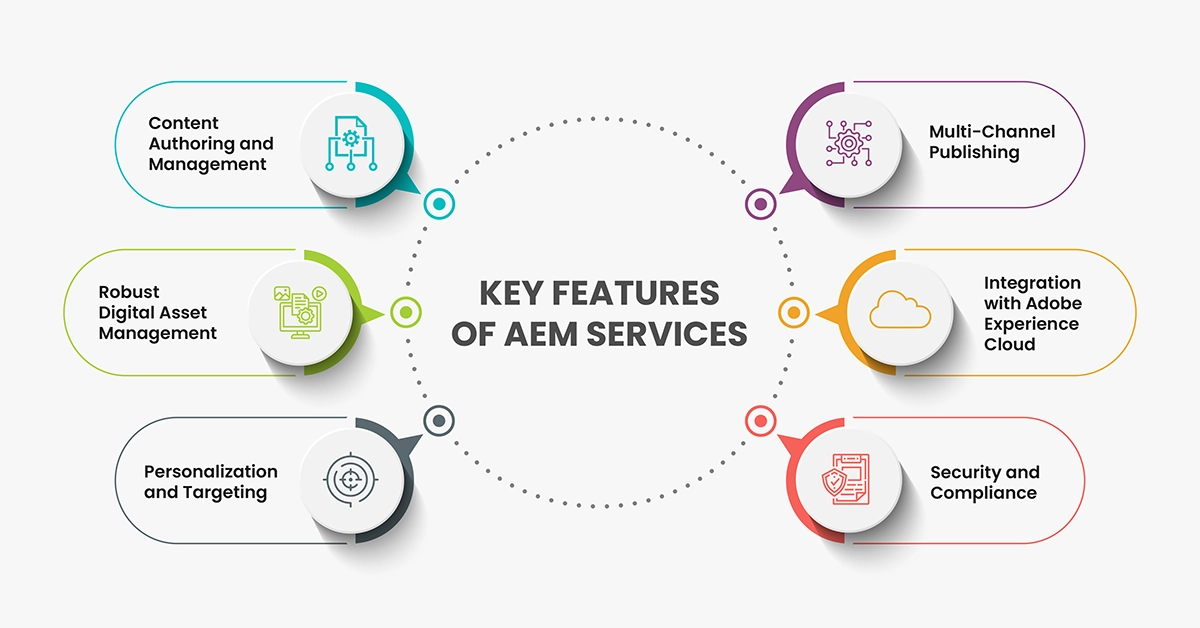Adobe Experience Manager (AEM) has been a trusted content management system (CMS) for delivering exceptional digital experiences. With the introduction of AEM as a Cloud Service, Adobe has taken AEM to new heights by combining its robust capabilities with the scalability and agility of the cloud. Organizations are significantly leveraging AEM services to deliver elevated digital experiences, streamline content workflows, and drive better business outcomes.
What Adobe Experience Manager is
Adobe Experience Manager (AEM) is a leading digital experience platform that enables organizations to create, manage, and deliver personalized digital experiences across multiple channels. It provides a comprehensive set of tools for content authoring, workflow management, digital asset management, and multi-channel publishing.
How Adobe Experience Manager Works
AEM leverages a modular architecture, which allows organizations to create custom experiences tailored to their specific needs. It uses a component-based approach, where content is created and managed using reusable building blocks called components. These components can be easily customized and combined to create dynamic web pages, mobile apps, and other digital experiences.
AEM also provides a flexible content repository for structured and unstructured content management. It supports various content types, including text, images, videos, and documents. This content can be organized using a hierarchical structure and accessed through a powerful search and navigation system.
AEM as a Cloud Service Architecture
AEM as a Cloud Service follows a cloud-native architecture that utilizes cloud infrastructure for scalability and agility. It leverages technologies like Adobe Managed Services, Adobe I/O, and Adobe Experience Cloud to provide a seamless and integrated experience. The architecture includes a scalable content repository, a global Content Delivery Network (CDN), and automated scaling and update processes.
What is New?
AEM as a Cloud Service introduces significant advancements and distinctions compared to traditional AEM deployments. Here’s a brief overview:
Cloud-Native Architecture: AEM as a Cloud Service utilizes a cloud-native infrastructure that automatically handles scalability, updates, and infrastructure management. Organizations no longer need to maintain their servers, enabling them to focus on other important aspects.
Continuous Delivery Pipeline: AEM as a Cloud Service follows a continuous delivery model, providing regular updates and improvements to the platform. This ensures organizations always have access to the latest features and enhancements without complex upgrade processes.
By embracing a proactive update approach, AEM as a Cloud Service keeps your projects running on the latest AEM version, delivering enhanced performance, security, and functionality without disrupting the user experience.
Key Features of AEM Services
AEM as a Cloud Service offers powerful features for creating, managing, and delivering seamless digital experiences:

Content Authoring and Management
Create, edit, and collaborate on content easily with a WYSIWYG editor and intuitive workflows.
Robust Digital Asset Management
Efficiently store, organize, and distribute digital assets with metadata management and seamless integration with Adobe Creative Cloud.
Personalization and Targeting
Deliver personalized experiences based on user segments, demographics, and behaviors, with real-time testing and optimization.
Multi-Channel Publishing
Seamlessly publish content across websites, mobile apps, social media, and email campaigns, ensuring consistent branding and responsive design.
Integration with Adobe Experience Cloud
Combine AEM with Adobe Analytics, Adobe Target, and Adobe Campaign for advanced analytics, personalization, and campaign management.
Security and Compliance
Benefit from robust security measures, regular updates, and tools for consent management and data governance to meet regulatory requirements.
With these features, AEM services empower organizations to deliver impactful digital experiences and streamline content workflows.
Benefits of AEM as a Cloud Service
Enhanced customer experiences: AEM empowers organizations to deliver personalized and engaging experiences to their customers. Its robust features enable content targeting, personalization, and A/B testing, ensuring customers receive relevant and compelling content.
Agile content management: AEM as a Cloud Service offers cloud-native agility, allowing organizations to adapt quickly to changing business needs. It provides scalable infrastructure, automated updates, and seamless integrations, enabling efficient content management and delivery.
Improved collaboration: AEM facilitates collaboration between different teams involved in the content creation process. It provides role-based access control, collaborative workflows, and real-time collaboration features, enhancing productivity and efficiency.
Advanced analytics and insights: AEM integrates with Adobe Analytics, allowing organizations to gain valuable insights into customer behavior and engagement. These insights can be used to optimize content, personalize experiences, and drive better business outcomes.
Integrating Experience Manager with other products
AEM seamlessly integrates with other products within the Adobe Experience Cloud ecosystem, including Adobe Target, Adobe Analytics, and Adobe Campaign. These integrations enable organizations to leverage advanced personalization, in-depth analytics, and efficient campaign management, creating cohesive and targeted experiences across channels.
Getting Started
To get started with AEM as a Cloud Service, organizations can follow these steps:
Assess business requirements: Understand your organization’s digital experience goals and identify the specific needs that AEM services can address.
Plan implementation: Define the scope of your AEM implementation, including content structure, workflows, and integration requirements.
Choose deployment options: Evaluate deployment options based on your organization’s preferences and requirements. AEM as a Cloud Service provides a cloud-native environment with built-in scalability and automated updates.
Onboard and migrate: Work with Adobe or a certified partner to onboard your organization onto AEM Services. Migrate existing content and configurations to the cloud environment.
Training and support: Provide training to your content authors, administrators, and developers to familiarize them with AEM’s features and capabilities. Leverage Adobe’s support resources and community forums for ongoing assistance.
Adobe Experience Manager as a Cloud Service brings the power of AEM to the cloud, providing organizations with a scalable, flexible, and efficient solution for managing digital experiences.
Embrace the transformative capabilities of AEM as a Cloud Service and revolutionize your digital experience strategy today. Connect with our experts to explore how AEM can aid your organization in driving better business outcomes.
Add new comment